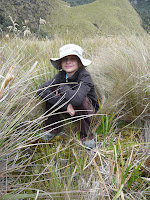So we decided that, although living in drafty rough cinderblock was fun and all, a little home improvement would be nice. We asked Carlos and Suzanna if it would be ok if we helped them out with a little project or two. The first thing to do would be to cover the cinder blocks with cement.
Perhaps a little explanation is in order. From our trip with Elnora to her house in the Philippines, we learned that construction and improvement of cement homes in countries like Ecuador often progess in the following manner: (1) after a family has lived in a thatch house (or with their parents) long enough to save some money, a rough cinderblock house is put together. This basically consists of cinderblocks with some cement mud in between, a rough cement floor (think barn floor) and a roof made of log poles and either tin or clay tiles; (2) after again saving some hard earned money, the family can afford to cover the cinderblocks with cement, giving a slightly more "finished" feel; (3) more saving, and then there is enough money to smooth the cement covering the cinderblocks and paint. This last step is awesome. When we stayed with Elnora, we had the chance to help her paint the downstairs of her house, and what a difference it made.
So the Lopez Perugachi family is in the second stage, and we get to help them put the cement onto the cinderblocks. We are excited for a more finished look, and also hope that the cement can keep out the drafts. We are also helping to put up plastic covering (basically really thick garbage bag type material) onto the ceiling to hopefully keep in some of the heat and keep the dirt, dust and spiders from coming down from the clay tiles. The tiles are not exactly affixed to the roof, but just laying down on the log poles. If there is a heavy rain, there are some places that water comes in through the roof, and also a fine misty spray comes floating down onto our faces while laying in bed.
Here is Carlos' friend (I forgot his name), who we have hired to slop the mud onto the walls. He is mixing the water with dirt and cement. Audrey apparently thinks she is in charge of quality control.

Perhaps a little explanation is in order. From our trip with Elnora to her house in the Philippines, we learned that construction and improvement of cement homes in countries like Ecuador often progess in the following manner: (1) after a family has lived in a thatch house (or with their parents) long enough to save some money, a rough cinderblock house is put together. This basically consists of cinderblocks with some cement mud in between, a rough cement floor (think barn floor) and a roof made of log poles and either tin or clay tiles; (2) after again saving some hard earned money, the family can afford to cover the cinderblocks with cement, giving a slightly more "finished" feel; (3) more saving, and then there is enough money to smooth the cement covering the cinderblocks and paint. This last step is awesome. When we stayed with Elnora, we had the chance to help her paint the downstairs of her house, and what a difference it made.
So the Lopez Perugachi family is in the second stage, and we get to help them put the cement onto the cinderblocks. We are excited for a more finished look, and also hope that the cement can keep out the drafts. We are also helping to put up plastic covering (basically really thick garbage bag type material) onto the ceiling to hopefully keep in some of the heat and keep the dirt, dust and spiders from coming down from the clay tiles. The tiles are not exactly affixed to the roof, but just laying down on the log poles. If there is a heavy rain, there are some places that water comes in through the roof, and also a fine misty spray comes floating down onto our faces while laying in bed.
Here is Carlos' friend (I forgot his name), who we have hired to slop the mud onto the walls. He is mixing the water with dirt and cement. Audrey apparently thinks she is in charge of quality control.

The mud is wheelbarrowed into the first room of the house. Jorie here is getting ready for a parade at her school (the subject of a different post).
Here the mud is flung onto the wall and smoothed. You'll notice a piece of tin that is covering the other side of the little window in the wall between the kids bedroom (where he is working now) and our bedroom. This is to catch the stray mud that flies off the mudflinging instrument. We thought we were going to catch everything, but apparently there are some holes in the wall, and the wall doesn't quite reach the ceiling. When we went into the next room, we saw that our water bottles and some clothes had a fresh coat of stray cement.
This is Jorie on the other side of the wall. Also note the sophisticated door covering and our cool, Hong Kong purchased luggage piece. Earlier in the day I did some quick work with Tandanda, moving the stored medicine and miscellany into a new storage closet. We found their small library and Jorie (who had been starved from English language books for 4 weeks, sat in this chair the whole day and nearly devoured a book. Not a children's book either.
































